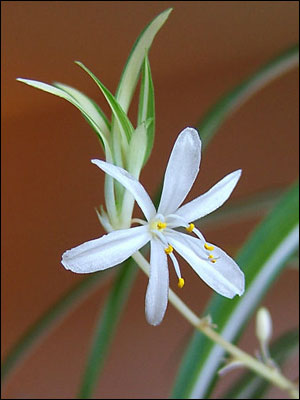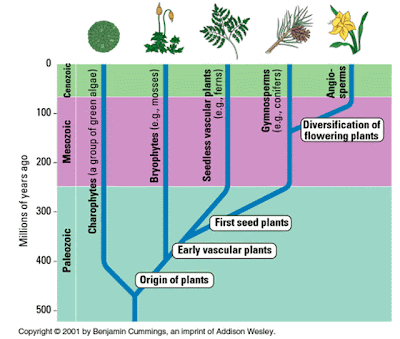Tuesday, March 22 Scribe Post! Today we started class by turning in our Flower Lab ( UP 41-44). Next we went over the Plant of The Day... which is called the "String of Pearls" (Senecio rowleyan). We learned that this plant is native to dry regions in south west Africa. It's leaf shape reduces the surface area to prevent water loss. It is also a "succulent" plant, which means that it is a water-retaining plant.[Image] [Image] Immediately after going over the P.O.D, Mrs. Stein asked us if we had any questions about the Lab quiz that we had today. After reviewing for a couple minutes, it was finally time to take the quiz. Then, after we took the quiz, we took a few notes about POLLINATION. Here are just a few KEY points that we took notes on: ~Pollination is the transfer of pollen from anther to stigma.~Self Pollination.~Cross Pollination.~Fertilization.~Double fertilization.~Coevolution.~Cross Pollination methods -Can be pollinated by wind and also a vector pollinator!~Seed Dispersal -Wind, Barbs that stick to animals, animals eat/excrete seeds. The HOMEWORK is as follows: -UP 45-46 colorcode. -Read 704 & 705. -PRESENTATIONS DUE TOMORROW Before 8:00 am! -Weird plants practical test on Thursday. -Plant TEST on Friday!!! The Next Scribe will be............ Natalie! Labels: CarolineR, Period2, Plant unit, Plants, scribe |
Thursday, March 24, 2011
Tuesday, March 22, 2011
Tuesday, March 22 Scribe Post!


Where are those powerpoints????
Monday, March 21, 2011
"That's Plant Sperm!"



Sunday, March 20, 2011
Thanks Dana!

 After doing the Demo lab shown above, we did a virtual lab at our lab stations. In this lab we also looked at transpiration, and we used the booklet shown below, to help determine the rate of transpiration.
After doing the Demo lab shown above, we did a virtual lab at our lab stations. In this lab we also looked at transpiration, and we used the booklet shown below, to help determine the rate of transpiration. We pretty much worked on the lab until class ended.
We pretty much worked on the lab until class ended. Thursday, March 17, 2011
Wednesday- Tuesday Big Lab!



 So to start of here are just a couple of photos of just a few of the 9 lab stations. You have station 5's radish plant were we learned about how the sunlight effects the plants growth. In this case the plant will actually tilt itself towards the light. Also in station 5 there was the corn. The corn showed the effect of gravity on a plant and its roots. Roots alway grow down because of gravity so when looking an the sideways corn seeds all the roots are trying to go
So to start of here are just a couple of photos of just a few of the 9 lab stations. You have station 5's radish plant were we learned about how the sunlight effects the plants growth. In this case the plant will actually tilt itself towards the light. Also in station 5 there was the corn. The corn showed the effect of gravity on a plant and its roots. Roots alway grow down because of gravity so when looking an the sideways corn seeds all the roots are trying to go - how to identify the Zone of Elongation found in the Meristematic Zone
- What the difference between Vascular and Nonvascular plants
- ----------What each has and doesn't have
- How gravity effects plant growth
- How sunlight effects plant growth
- ----------Temperature and position
- Difference between Dicot and Monocot and how to identify them
Tuesday, March 15, 2011
Plants are interesting...more or less

P.O.D The Moss Ball

Homework 23.2 & 23.3 w/ Double Bubble Map - "Stems vs. Roots"
Nation Parks Project due 3/23
The next scribe will be...Dana
Monday, March 14, 2011
Sunday, March 13, 2011
Thursday, March 10, 2011
PHOTOSYNTHESIS
- reactants: co2 h2o light and energy
- Products: o2 c6h12o6
- Two reactions
-light reaction
-Calvin cycle
Chloroplast Structures
- Thylakoids - sacs contain chlorophyll
- Granum - stacks of Thylakoids
- Stroma - open space and where Calvin cycle occurs
After the notes with finished a lab we had started called the pigment lab. i cant get the pictures uploaded but it was a cool lab. What we did was take 2 leaves, a spinach leaf and red leaf and used a coin to crush and press pigment onto a Chromatography paper After that we took the paper rolled in, stapled it, and dropped it into a solution for 10 minutes. When taking it out we saw an array of colors separated on the paper. These colors were the pigments found in the plant. In the paper there was 2 greens, 2 yellows, and a red. Whereas in the spinach leaf we saw only 2 greens and 2 yellows. This shows us that even though you may only see red or green, there can still be many many more pigments. That's why even though the red leaf is red there is still chlorophyll to carry out photosynthesis.
homework:
- finish lab analysis questions
- Do notes on 8.2 and 8.3 or complete Up pages 81-85
- Work on national park paper
Fridays Class
Today in class we went down to the lab to work on our National Parks paper. We also went over how do do a correct PowerPoint...
- No bright colors
- Font should be readable
- Not to much info on a page (In communications we leard to only have 5 pionts with 5 words)
- make sure colors dont blend with words
- don't make things to busy on the page
- and.....DONT OVER LOAD ON THE ANIMAL SLIDES, STICK TO PLANTS
the homework is;
- finish National Parks paper 3/23
- Read pages 643 and 664-666
Wednesday, March 9, 2011
"Does it eat spiders?"
The Plant of the Day is... the Spider Plant. It can self-propagate, meaning it can take a part of itself and grow a new plant out of that part. It is native to South Africa, however it is a common house plant. It is also a flowering plant.
We mostly discussed ATP, Energy, and Visible Spectrum.
Things about visible spectrum:
- Light travels in waves
- Each color has a diferent wavelength
- There are some colors we cannot perceive (i.e. ultra violet, infared, etc.)
- All the colors put together will make white
- Color can be absorbed and/or reflected
Note: Energy is what makes you do stuff, and ATP has Adenine, Ribose, and 3 Phosphate Groups
Homework:
- Unit Packet 67-68, Due Date: Tommorow
- Read Section 8.2 and 8.3 with Unit Packet 81-85 OR a reading strategy/notes of your choice, Due Date: Tommorow
- National Park Research, Due Date: 3/23/11

A Spider Plant Flower.
Next Scribe is...Alex.
Tuesday, March 8, 2011
Structures of a Leaf
After we observed the venus fly trap, we started a lab dealing with the structure of a leaf. In the lab we observed a prepared slide of lilac leaf and a walking jew leaf.
The next scribe will be Sam.
Homework:
-Finish leaf lab.
-National Parks Project





Plant Kingdom!
We also examined our weird plant of the day - the baseball plant. It is a succulent that can store water to allow it to survive in dry environment.
Below is an image of the plant kingdom. You will be responsible for knowing the basic characteristics of each group of plants!








